Imagine a clown in front of a circus tent, holding about 30 colourful balloons in his hand.
Or a huge flowery meadow near the woods, everything is blooming and growing.
It doesn’t matter whether we look at skittles, your chef’s ferrari or delicious fruits
– all of those are nothing without their colours. We could not imagine the pictures of them, if it wasn’t for the typical red of the ferrari or the green, blue, yellow etc. of the clowns balloons.

Now it’s time to talk about colours and why they are one of the most important things in photography. They bring in a huge spectrum of new opportunities and possibilities in the use of cameras and photoshop, that’s why we want to look at them a bit closer.
However, before we start, we are going to chat a little about white balance. This part is important and interesting as well because white balance is one of the tools which can change your image colors extremely.

White balance is a part of every digital camera, which measures the color temperature of the available light. Once measured, the camera tries to adjust its settings: the white you see should also a be white in the picture. Every light source emits different color temperatures which have different wavelength of the visible spectral range. The longer the waves are, the more reddish the light appears. On the other hand does the light appear more blueish the shorter the length are.
- The problem:
- Die Lösung:
 But why are we telling you this? Well, let’s assume you have your lights set up and you put gels on them. The gels are going to eliminate all wavelengths that do not match the gel color.
But why are we telling you this? Well, let’s assume you have your lights set up and you put gels on them. The gels are going to eliminate all wavelengths that do not match the gel color.
To have balanced lighting you can use a gel which adjusts the temperature of the flashlight to the ambient temperature.
In studio photography you rarely have to compensate color temperatures. Nevertheless gels are very useful as effect lights. Now setting the white balance manually gets important again, because if it is set at around 5500 Kelvin, you will get exactly the color your gel has.
The application for gels are very diverse. Basically you can create lighting situation close to reality or you imaged surreal settings. Most common gels are CTB and CTO, where CTB stands for “Color Temperature Blue“ and “CTO” for “Color Temperature Orange”.
 If you want to imitate the atmosphere street lights produce, CTOs or yellowish gels are your choice. The colored light source should be positioned as in reality, for example like a “street light” high and maybe used as rim light for the model.
If you want to imitate the atmosphere street lights produce, CTOs or yellowish gels are your choice. The colored light source should be positioned as in reality, for example like a “street light” high and maybe used as rim light for the model.
In this setup, we recreated a street light scene for you: Download
Hey, listen up! Want to know a cool trick on how to get an evenly illuminated background?

–> By tipping the upper side of the light shaper slightly forward. Now the light propagation changes and the background gets evenly illuminated for our portrait. Unfortunately, this trick is not suitable for full body setups. If you own a second light shaper, you can get around this by setting the background like this.
Psychology combined with colours
Which one is your favourite colour? You are free to choose! ;)
- Red
- Green
- Blue
- Yellow
- Black
- White
- Grey
Setups
Now it’s the time when show you a few setups, which we consider to be very suitable for working with colors.

This setup shows you how CTO and CTB filters work. The first snapshot in the file shows you how the image looks when the white balance is set to “flash” (5500K) and the secound gives you a white balance set onto the gel.

In this setup you work with cold and warm gels. The different positioning of the light sources shows you the different effects that can be achieved with these gels.
 In the last setup, we put together various types of contrasts which talked about above. In addition, the set-file includes two possible setups of a street scene.
In the last setup, we put together various types of contrasts which talked about above. In addition, the set-file includes two possible setups of a street scene.You have seen in which ways colors can influence your images. There are many fascinating possibilities how to use color contrasts in your pictures. Especially studio photography is well suited to use this with a few creative ideas.
We are really looking forward to what you will come up with.
Quick Links…
–> set.a.light 3D
–> Facebook
–> Instagram
If you have not joined set.a.light 3D’s Facebook group yet, we would be delighted to meet you there and exchange setups and ideas.
This post is also available in: German
 elixxier – Photo Blog Light settings and lighting structures for studio and outdoor photography. Tips and tricks for set.a.light 3D – The photo studio and light simulation for photographers.
elixxier – Photo Blog Light settings and lighting structures for studio and outdoor photography. Tips and tricks for set.a.light 3D – The photo studio and light simulation for photographers.
